
The Amazing Micro-Four-Thirds Format
—and how it compares to full-frame Sony a7II

by Richard Rivera
When Olympus released the 5-axis in-body sensor-shift image-stabilized Micro-Four-Thirds OM-D E-M5 in April 2012, it established a new precedence and level of achievement in mirrorless technologies. The clear advantage of implementing sensor-shift stabilization, where the movement of the sensor compensates for any user motion and thereby enhances sharpness by eliminating motion blur, is that any lens from any manufacturer can benefit from the camera’s in-body stabilization (and be utilized with the proper adapter).
Although other camera manufacturers such as Canon, Nikon, and Panasonic, etc., had stabilized lens systems that optically compensate for user camera shake in either compact cameras** or standalone lenses,*** Olympus was the first to address in-body stabilization in a DSLR with their EVolt E-510. The Olympus EVolt E-510 was a Four-Thirds DSLR that implemented 2-axis sensor-shift IS.
On December 2014, approximately one year after Sony released the world’s first full-frame AF mirrorless digital camera, Sony finally released the a7II, a full-frame mirrorless camera that incorporates 5-axis in-body image stabilization that will work with just about any lens. [Ed.Note: technically, the world's first digital mirrorless was the Leica M8.]
I think of the Micro-Four-Thirds format as amazing because of the image quality that Olympus and Panasonic have been able to achieve with such a small sensor. As they say, the “proof of the pudding is in the eating,” and unless you have handled a Micro-Four-Thirds and seen one of its 40 x30 inch prints, it is difficult to describe. The quality however, is easy to see. Which brings me to the current flagship of the Olympus line: the OM-D E-M1.
I have been fortunate enough to work with several generations of Micro-Four-Thirds cameras, Panasonic (GH-2, GH-3) and Olympus models (EP-1, E-P2), as well as several Sony mirrorless models (NEX-5, NEX-5n, NEX-6, and NEX-7) which use the slightly larger APS-C sensors. Having worked with and thoroughly enjoyed the E-M1, which also employs Olympus’ 5-axis in-body image stabilization, I was curious to see how it would compare to the Sony a7II in handling and image quality.
Since the E-M1 is fully compatible with all Panasonic Micro-Four-Third lenses, I used it with the Panasonic 45-150mm f/4-5.6. The Sony a7II was used with the Sony FE 70-200mm f/4.
WEIGHT
Although each lens balances very well on their respective camera body there is quite a difference in weight. Each system was weighed with a battery and SD card in the body.
Panasonic 45-150mm 7.1oz
Olympus E-M1 (body) 1.09 lb. ( 17.5 oz)
total = 24.6 oz (1.5 lb)
Sony a7II (body) 1.22 lb. (19.6 oz)
Sony FE 70-200mm 1lb. 13.63oz (29.63 oz)
total =49.23 oz (3.07 lb.s)
As you can see, although both lenses have a maximum aperture of f/4, the Sony outfit was roughly twice the weight of the E-M1 kit. It should also be noted that the Micro-Four-Thirds Panasonic lens on the E-M1 covers the same field-of-view as an equivalent 35mm full-frame zoom of 90-300mm while weighing nearly one-third that of the Sony FE 70-200mm. [Ed.Note. Olympus does make a premium PRO 40-150mm f/2.8 that is considerably heavier and costlier than the Panasonic 45-150mm.]
HANDLING
Both cameras handled extremely well but in different ways. Despite the fact that the Sony a7II is heavier, it balanced excellently with the FE 70-200mm and focused quickly. Controls for aperture, ISO, and +/- compensation are smooth and at the fingertips, as well as switching to Manual focus on the lens. The Olympus E-M1, tiny by comparison, handled beautifully while seamlessly changing aperture or +/- compensation, but ISO or Manual Focus were not as easily accessible. And although the EVFs on both are 2.3 mil dots, I did notice that the EVF on the Sony exhibited greater dynamic range from highlight to shadow, making it a bit easier to see detail in high contrast situations.
Reviewing images in playback was excellent on both cameras but in different ways. While on the E-M1, the touchscreen is a huge bonus in quickly reviewing images on the LCD, as well as scrolling and zooming, viewing them through the viewfinder was a bit clumsy by using the rear-dial to enlarge or reduce the view. The Sony lacks a touchscreen LCD but makes it easy to enlarge to maximum in one-step via the Magnify button, and then reduces with a single-click on the main control button, but scrolling or panning was slow. Both cameras exit playback with a light touch on the shutter release button.
One excellent feature of the E-M1 that I wish Sony would employ in their camera is the ability to shoot continuously while in Magnified Mode, which I found extremely useful when either shooting Macro or in Manual Focus.
THE BIG QUESTION
The big question in my mind was since the E-M1 is a Micro-Four-Thirds sensor and the Sony a7II a full-frame one, I was very curious as to whether the Sony would give me 4 times the image quality or detail than the much smaller sensor. You may be surprised by the results shown below.
IMAGE QUALITY
In shooting side-by-side with the E-M1 and the full-frame Sony a7II, I was truly surprised at the image quality differential between a 24MP full-frame and a 16MP Micro-Four-Thirds sensor that is one-fourth the area. There are many technical variables between the two that account for discrepancies, such as pixel pitch, sensor noise, photon-shot noise, and proprietary algorithms for analog-to-digital conversion, but the best judge is one's eyes. How does it look? There is a difference but one has to view it long and hard to ascertain what the difference actually is. It is in the subtleties.
I must admit that when I took both cameras to photograph the owls I did not do so with a scientific comparison in mind. If I had, then I would have used a tripod and shot at the exact same shutter speed, focal length, etc. But I was so surprised at the results that I thought others might also be interested in seeing what I had stumbled upon. I for one, assumed a dramatic and obvious difference by at least a factor of two—that the full-frame should be at least twice as sharp, detailed, etc., but I will let you be the judge.
IMAGE TEST 2
Another example is shown below. This time both cameras were mounted on tripods and the following images were shot within minutes of each other, from the exact same distance. The same field-of-view was retained in both for consistency. The Sony was set at its maximum zoom length of 200mm and the Olympus matched for field-of-view at 100mm. Depth-of-field differences are apparent in examples B, and D, shots from the full-frame Sony a7II.
There is no denying that the larger sensor captures more detail (as seen in images C and D) when photographed within the limitations of equal field-of view and distance.
Interesting points of comparison in images E and F (at bottom) are the black sticker with white lettering near the center of the shot, as well as the grille in the corner of the windshield. Also, in E and F, please note the padlock in the bottom left corner.
Point for point each system has its strengths, but the degree of detail that Olympus
has managed to extract from a small sensor one-fourth the area of the full-frame is remarkable.
* * *
WHY THE NAME “MICRO-FOUR-THIRDS”?
When Olympus and Panasonic decided to create the Micro-Four-Thirds format in 2008 they essentially modified the Four Thirds format that had been created in 2002, and which had originally been spurred on by the cross-licensing agreement between Eastman Kodak and Olympus in 2001.*
The intent of the Four Thirds sensor (same sensor used in Micro-Four-Thirds format), which is approximately one-fourth the area of a 35mm full-frame, was to design a wholly digital standard interchangeable lens system for digital cameras that would increase mobility through size reduction. The Micro-Four-Thirds format however, modified the Four Thirds model further by removing the mirror-assembly of the DSLR (digital single-lens-reflex)* system, and replacing the optical viewfinder with an electronic continuous Live View system that could function with or without an electronic viewfinder (EVF). Hence, the initial offerings in the Micro-Four-Thirds format in 2008 were the Panasonic G-1, which sported a built-in EVF, and Olympus’ PEN E-P1 which did not have an EVF.
*http://www.dpreview.com/articles/1261925083/kodakolympus
**Nikon VR lens 38-105mm in the compact Nikon Zoom-touch 105 VR, 1994
***Canon IS lens EF 75-300mm f/4-5.6, 1995
June 2, 2015
Your feedback and comments are appreciated. See Contact page for e-mail.
I was told of this family of owls within walking distance and decided to photograph them one evening. I shot with both, the Sony a7II with the FE 70-200mm (immediately below), and the Olympus E-M1 with the Panasonic 45-150mm (bottom image), handheld, each at their maximum zoom.
The E-M1 image looks larger because the field-of-view of the Panasonic at 150mm is that of a 300mm. The images shown below are the uncropped frames from each. Detailed close-ups are shown below the full shots.



www.sony.net
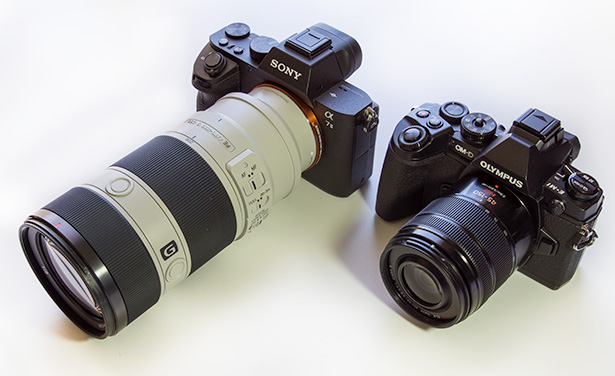
Richard Rivera © 2015
Above: the Sony a7II shown with the Sony FE 70-200mm f/4 G OSS lens alongside the Olympus OM-D E-M1 and the fully compatible Panasonic 45-150mm F/4-5.6. Below: back-to-back, the two cameras show very little difference in the actual body width. Both sport substantial grips. The Sony body is a bit heavier.
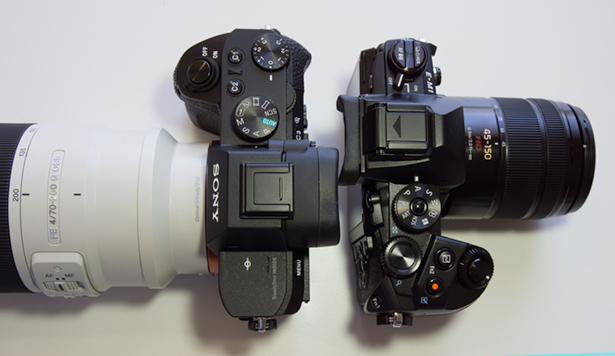
Richard Rivera © 2015
DETAILED CLOSE-UPS
Image A (taken with the Sony a7II), and B (taken with the E-M1), shown below are 100% cropped details of the images shown in full at top. The owl was photographed with the Sony at f/8 ISO 320, and with the Olympus at f/7.1 at ISO 200. Images were processed with Adobe Camera Raw v.8.7.1 in Bridge, and both were minimally sharpened to the same degree.
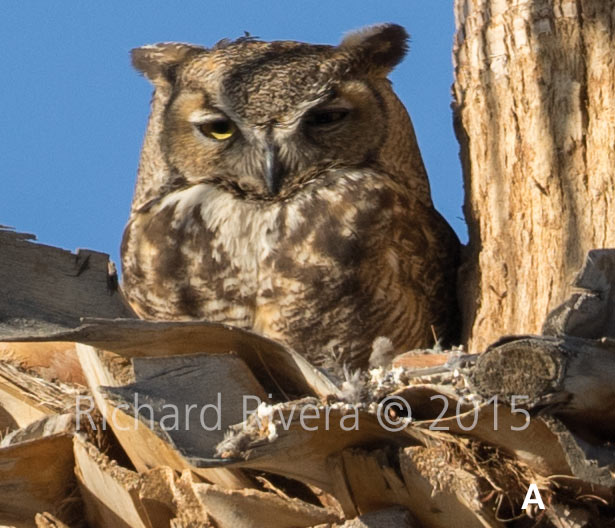

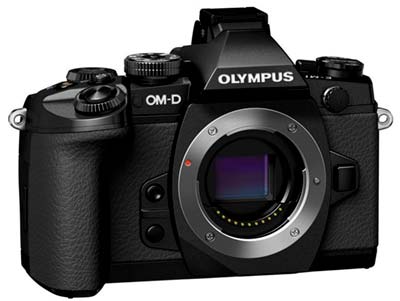
www.olympusamerica.com
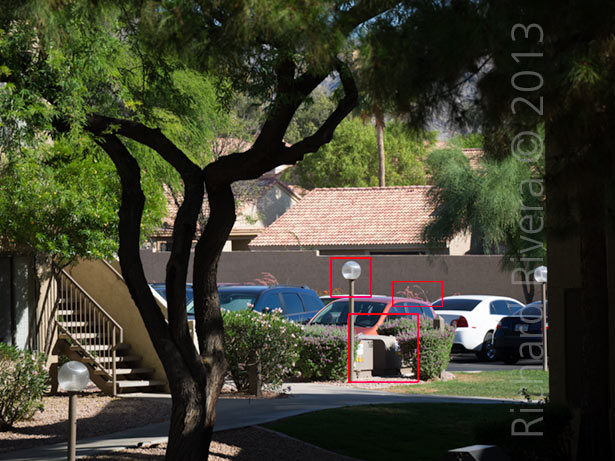
Two test shots were taken, one with each camera, with the same exact field-of-view (Sony a7II at 200mm, Olympus E-M1 at 100mm). Point of focus was the windshield of the red car. The test shot above shows the uncropped full image, with detail close-up areas outlined in red, and shown below. Details are shown at 100%. Field-of-view was identical for both test images. Cropped details at 100% reflect the full native pixel dimensions for Olympus (4608 x 3456) and Sony (6000 x 4000). Auto White balance was used for both cameras. The shallow depth-of-field of the full-frame a7II is apparent in the “blooms” (B) and the “sidewalk lamp” (D).

A. Blooms taken with E-M1
B. Blooms taken with a7II
C. Sidewalk lamp taken with E-M1
D. Sidewalk lamp taken with a7II
E. Car detail taken with E-M1
F. Car detail taken with a7II
Exposure: ISO 200
Olympus E-M1 f/5.6 @ 1/500sec
Sony a7II f/6.3 @ 1/640sec
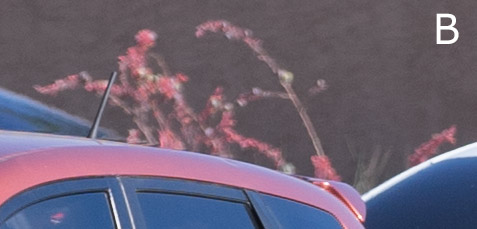
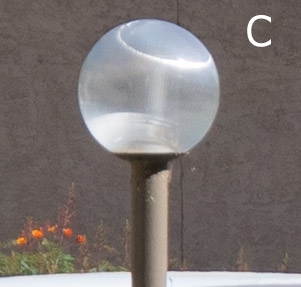


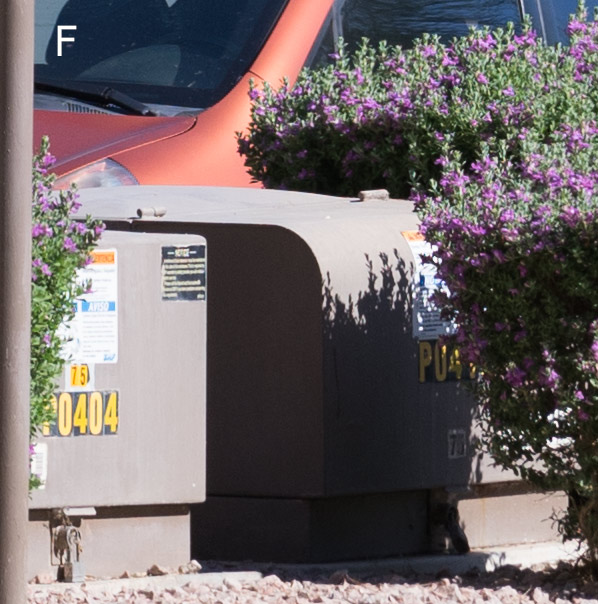
DIFFRACTION: A CAVEAT ABOUT MICRO-FOUR-THIRDS
I should add one further note to those interested in Micro-Four-Thirds. Several reviewers have commented that because of the size of the Micro-Four-Thirds sensor, it is prone to loss of sharpness with apertures greater than f/8 due to diffraction. In fact Fuji also tries to address the problems of diffraction by enabling LMO (light-modulation-optimization) in their Fuji X-T1 (which is an APS-C size sensor).
I first encountered diffraction when shooting close-up and macro work decades ago. As we encounter shallower depth-of-field in close-up and macro photography we are tempted to use smaller and smaller apertures. This is can be a mistake because we will find that as we use smaller apertures (f/16, 22, etc.) our images
will becomes increasingly soft rather than sharper. The problem is diffraction.
“At very high magnifications, usually greater than 0.5x (half-life size), apertures
of f/16 and smaller will actually give poorer results due to a light propagation phenomenon call diffraction.” I quote from, The Manual of Close-Up Photography by Lester Lefkowitz. Hence, many macro photographers use the technique called “photo stacking” which combines several sharp exposures together to create a single image.
Gordon Laing, who runs cameralabs.com encourages shooting with Micro-Four-Thirds wide open or at apertures no smaller than f/2.8 or f/4. I personally have experimented with shooting at f5.6 and f/7.1 which seems to be point at which there is noticeable loss of sharpness through diffraction, but this is greatly influenced by the quality of the lens you are using. However, it is something to keep in mind and test for yourself.
Recommended: Gordon Laing & Doug Kaye on diffraction (at 46min 45sec mark)
https://www.youtube.com/watch?v=Ojq29oY0o34
The link here to the dpreview.com LENS widget shows in graphic terms at what aperture a lens has the sharpest performance (resolving a greater amount of lines per millimeter), vignetting, and chromatic aberrations. Note that with 35mm lenses stopping down to smaller apertures of f/22 and f/32 actually yields less resolution.
Diffraction happens when apertures become so small that light bends around the opening and light rays spread instead of properly focusing.
And since apertures are related to sensor size, the “equivalent” aperture on a
micro-four-thirds camera will be different than on a 35mm. This link shows that an equivalent aperture of f/3.2 in 35mm (full-frame) will be f/1.6 in micro-four-thirds.
http://www.dpreview.com/articles/2666934640/what-is-equivalence-and-why-should-i-care/3
Copyright © 2015 Richard Rivera & Rivera Arts Enterprises All rights reserved. No copying or reproduction of any kind without express written permission from Richard Rivera
Legal Disclosure Camera Sense and Eagles of New York are trademarks of Elk Partners LLC